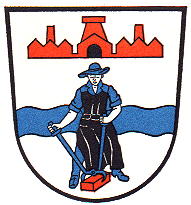Hüttental: Difference between revisions
Knorrepoes (talk | contribs) m (Text replace - "|width="15%"|50 px|right |}" to "|width="15%"|50 px|right |}<seo title="Wappen, Gemeindewappen" />") |
Knorrepoes (talk | contribs) m (Text replace - "[[Literature" to "{{media}} [[Literature") |
||
| Line 22: | Line 22: | ||
The upper half is derived from the arms of Weidenau, the lower from Geisweid. The arms as a whole are partly canting (Hütte=factory) and symbolise the importance of heavy industry for the municipality. | The upper half is derived from the arms of Weidenau, the lower from Geisweid. The arms as a whole are partly canting (Hütte=factory) and symbolise the importance of heavy industry for the municipality. | ||
{{media}} | |||
[[Literature]] : Stadler, K. : Deutsche Wappen - Bundesrepublik Deutschland. Angelsachsen Verlag, 1964-1971, 8 volumes. | [[Literature]] : Stadler, K. : Deutsche Wappen - Bundesrepublik Deutschland. Angelsachsen Verlag, 1964-1971, 8 volumes. | ||
Revision as of 23:15, 8 July 2014
| Heraldry of the World Civic heraldry of Germany - Deutsche Wappen (Gemeindewappen/Kreiswappen) |
HÜTTENTAL
State : Nordrhein-Westfalen
District (Kreis) : Siegen-Wittgenstein (until 1975 Siegen)
Additions : 1966 Amt Weidenau, Birlenbach, Buchen, Dillnhütten, Geisweid, Langenholdinghausen, Meiswinkel, Niedersetzen, Obersetzen, Sohlbach, Weidenau (1937 Buschgotthardshütten (partly))
Incorporated into : 1975 Siegen
Official blazon
Origin/meaning
The arms were granted in 1968 and combine elements from the arms of the former municipalities.
The upper half is derived from the arms of Weidenau, the lower from Geisweid. The arms as a whole are partly canting (Hütte=factory) and symbolise the importance of heavy industry for the municipality.
Contact and Support
Partners:
Your logo here ?
Contact us
© since 1995, Heraldry of the World, Ralf Hartemink 
Index of the site
Literature : Stadler, K. : Deutsche Wappen - Bundesrepublik Deutschland. Angelsachsen Verlag, 1964-1971, 8 volumes.











